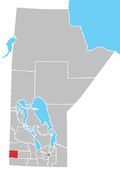Findlay | |
|---|---|
Location of Findlay in Manitoba | |
| Coordinates: 49°34′5″N100°45′27″W / 49.56806°N 100.75750°W | |
| Country | |
| Province | |
| Region | Westman Region |
| Census Division | No. 6 |
| Government | |
| • Governing Body | Rural Municipality of Sifton Council |
| • MP | Grant Jackson |
| • MLA | Colleen Robbins |
| Time zone | UTC−6 (CST) |
| • Summer (DST) | UTC−5 (CDT) |
| Area codes | 204, 431 |
| NTS Map | 062F10 |
| GNBC Code | GAIEE |
Findlay is a locality within the Rural Municipality of Sifton in southwestern Manitoba, Canada. It is located approximately 34 kilometers (21 miles) southeast of Virden, Manitoba. [1]

